Tips on how to select vehicle LEDs
When it concerns road safety, being aware of your surroundings is not enough; you have to be totally aware of your car too. Burnt-out or dim vehicle lights can cause you to have a collision. LED lights are energy saving, and can last as long as your car. They make sure you are always visible to other motorists.
What are LED lights?
A guide to automotive LED lighting
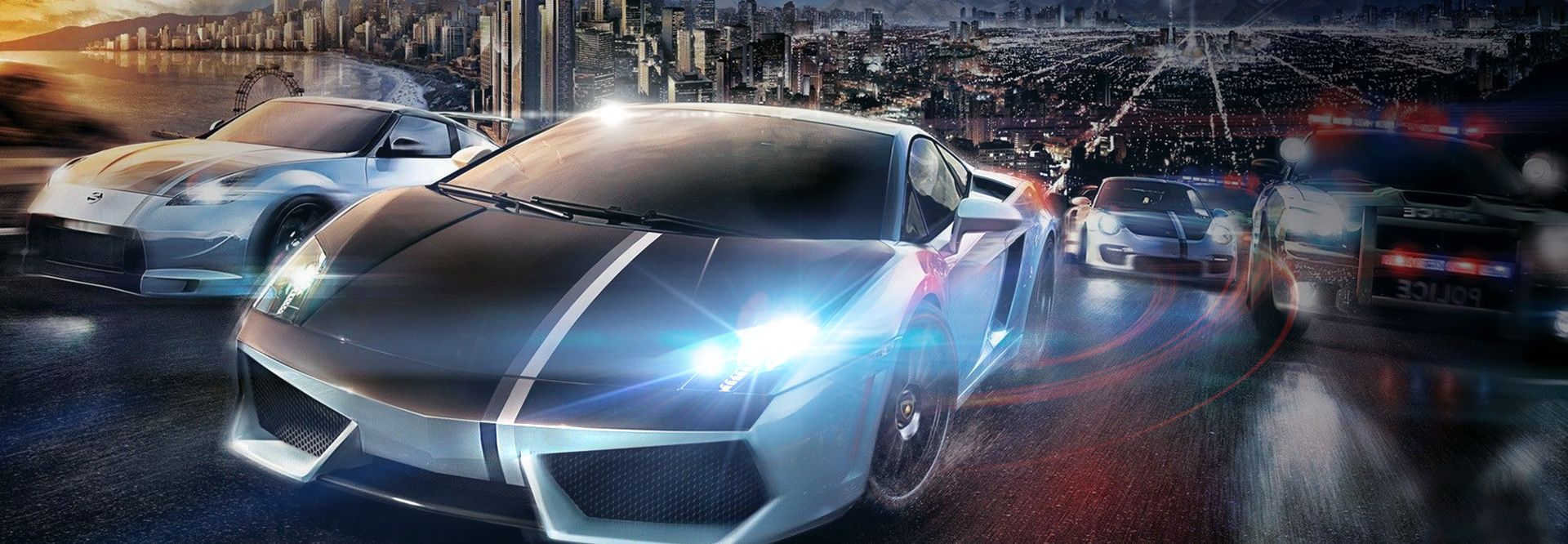
Photo on anycarled.com
LED is an acronym standing for Light-emitting diode. A diode is an electrical component with two electrodes through which electricity flows. They are generally made of semiconductive materials like silicone or selenium-these substances only conduct electricity in certain conditions and not others, e.g., at certain voltages or current levels. An LED emits a visible bright light when electricity flows through it. They are ranked between halogen and HID lamps in regards to their luminescence, but LEDs can provide more focused light. Here are the advantages and disadvantages of LEDs
- Their small size allows manufacturers to create all kinds of shapes and assemblies that perfectly match the car models, no more unsightly dome reflectors.
- They are brighter than halogen lights and have a warmer glow than HIDs
- They are energy efficient as they produce more light per watt than incandescent bulbs. Their efficiency is not affected by the size or shape of the lighting fixture, unlike fluorescent bulbs and tubes.
- They can emit a certain color light without the use of color filters. This can also lower the initial cost of the bulbs or lighting kits.
- They are small, so they can easily be attached to printed circuit boards.
- They light up fast, requiring very little warm-up time.
- They are ideal for use in systems that require frequent turning on and off. They will not fail over time due to this use, like incandescent or fluorescent bulbs or need long startup time like HID bulbs.
- They can easily be dimmed using pulse-width modulation or lowering the forward current. Pulse-width modulation. Especially in headlights, can cause the light to flicker or flash.
- The bulbs radiate very little heat.
- They can last for a long while and do not abruptly fail like incandescent bulbs.
- They are durable, with high shock resistance because they are made of solid-state components, unlike fluorescent or incandescent bulbs which can be damaged easily by eternal shocklike in an accident.
- They are designed to focus the light they emit, unlike incandescent sources which need an external reflector to gather and direct the light.
- They are eco-friendly.
Disadvantages:
- They can have a high initial cost due to the extra circuitry and supplies needed to be installed in the car.
- LED performance is highly dependent on the ambient temperature of the environment it is in. The high temperatures can cause failure thus a heat sink is needed to maintain the long life of the LED light. Opt for a copper heatsink and not an aluminum one as it will last longer.
- They have high voltage sensitivity
- They can only work when certain electrical polarity conditions are met.

Photo on trentled.com
Why switch to LEDs?
LEDs can give your car a clean, modern look and when used properly, they can last longer than any halogen bulb or even your car. The low energy use, high-lumen output and instant on/off LED technology surpasses all other bulbs. They can be seen during the day and light up quickly making them ideal for car brake lights and turn signals. A typical LED assembly is designed to replace a conventional bulb. Several small LEDs are grouped together and when they light up the can produce light equal to or even greater than that of incandescent bulbs.LEDs can produce an array of colors from a single bulb. These color-changing LEDs are known as Red-Green-Blue (RGB) LEDs. They may contain three different LEDs in one bulb unit or be a single LED coated with various substances to emit red, blue or green at different voltages. Varying the voltage can result in any combination of the three colors, and they can change between hues quickly or slowly.This multicolor feature is especially useful in making one lighting assembly perform a lot of functions, e.g., a red rear light can brighten in brake mode, blink amber when indicating on turns and turn white when reversing. Another good example is daytime running lights that can switch from white to amber, and by flashing, they can double up as turn signals. Depending on the circuit configuration, LEDs can light up simultaneously as a unit or sequentially to create flowing turn signals.Ultimately, the save you money as they last longer and usually need little to no replacement. It is vital to know that there are some laws govern the use and installation of aftermarket LED lights, be sure you comply with the regulations when choosing the type and color to use.
Automotive LED lights
Car LED applications
When choosing LEDs and LED kits, there are a few things you must take into consideration first:
For LED bulbs
- Go for lumens not watts – Just like how you choose incandescent bulbs by their wattage, LEDs are graded by their lumens so choose the correct one to replace the incandescent bulb or upgrade it. Most bulbs used in cars range from 35 – 55 watts depending on the type of bulb used. So go for LEDs with a lumen rating ranging from 450 – 1,100 or 4 – 13 LED watts
- Get the right color you want/need – LEDs come in many different colors, from a warm yellow like incandescent bulbs to a whiter white or a bluish white. Checking the color temperature can help you know the light color emitted by a certain LED bulb. A high number on the Kelvin scale, which is used to measure color temperature, means it is a cool-colored light, while a low number means it is a warm-colored light.
- You must match the bulb shape to the fixture – LEDs are available in a vast number of strange shapes when choosing an LED bulb to fit into the head or tail light, be sure to get one that matches the fixture.
For LED kits
- They must be easy to install and can fit all models to reduce compatibility issues. Go for kits that do not require any special skills to install.
- Choose good quality, durable kits that will last while providing a brilliant, high-quality light.
- It is vital that you avoid cheap kits trying to save some money as they are more trouble than they are worth. Quality LED kits are a good investment, and they can save you money in repairs, in the long run.
Most automotive LED lighting falls into two broad areas depending on where they are located: either on the outside or inside the car.

Photo on bestheadlightbulbs.net
LED light application areas
LED light bars
These lights can be used for off-road driving, as daytime lights or as high-power fog lights. Because they are LED, they use up very little power and give off a lot of light. These light bars are easy to install. LED tailgate light bars enhance the visibility of your tail lights and back turn signals. They are available with a variety of functions like reverse lights, turn signals, running and brake lights. They improve the appearance and safety of the carWhile choosing what LED light bars to go for factor in:
- The size if the light bar you need – keep in mind where and how you plan to mount the bar
- The shape of the bar – they come in three basic forms; round, square and rectangular. The shape can have a slight effect on the light, but deciding on the shape is really a cosmetic decision.
- The beam pattern of the light bar.
- The color of the LEDs – LEDs are available in a variety of colors such as white, amber, amber-white, red-white, and blue. The choice of color is a personal preference, but some LED colors have some advantages over others.
- The brightness of the LEDs in the bar
- The features present in the light bar like how many rows of lights they have. A multibeam bar can allow you to turn different lights on and off separately.
- The water-resistant capability of the light bar
- The voltage of the bar and what connectors are used to connect it to the car’s electrical system.
Daytime running lights
They are located at the front of the car, and they remain on whenever the vehicle is running. Unlike headlights, they are relatively dim and are not used to illuminate the road. They instead increase the visibility of the car to other motorists.
LED Halo rings
They are also known as angel eyes and area an accessory light installed over or incorporated into a car’s head or tail light assembly. They do not replace the head or tail lights but are merely accessory lights which can double up as daytime running lights.
LED grilles
These are LED lights added as an accessory feature on car grilles. They can feature a wide variety of light patterns on the front of each grille, from bars, cubes, and round lights. They not only add character to the car and are the most eye-catching accessory you can have, but also brighten up the road while driving.
LED headlight kits
You can use LEDs to upgrade the quality of your headlights, replace a broken headlight, or just for aesthetic reasons.
LED underbody or chassis lights
These lights are used to light up the bottom of the car. They provide a simple way to modify your car and make it look cool. When deciding on an LED kit, go for one that matches your car model. If you cannot find one opt for LED strips, they are also a good option. They, however, are not weatherproof and you will need to take measures to protect them from weather and debris damage.
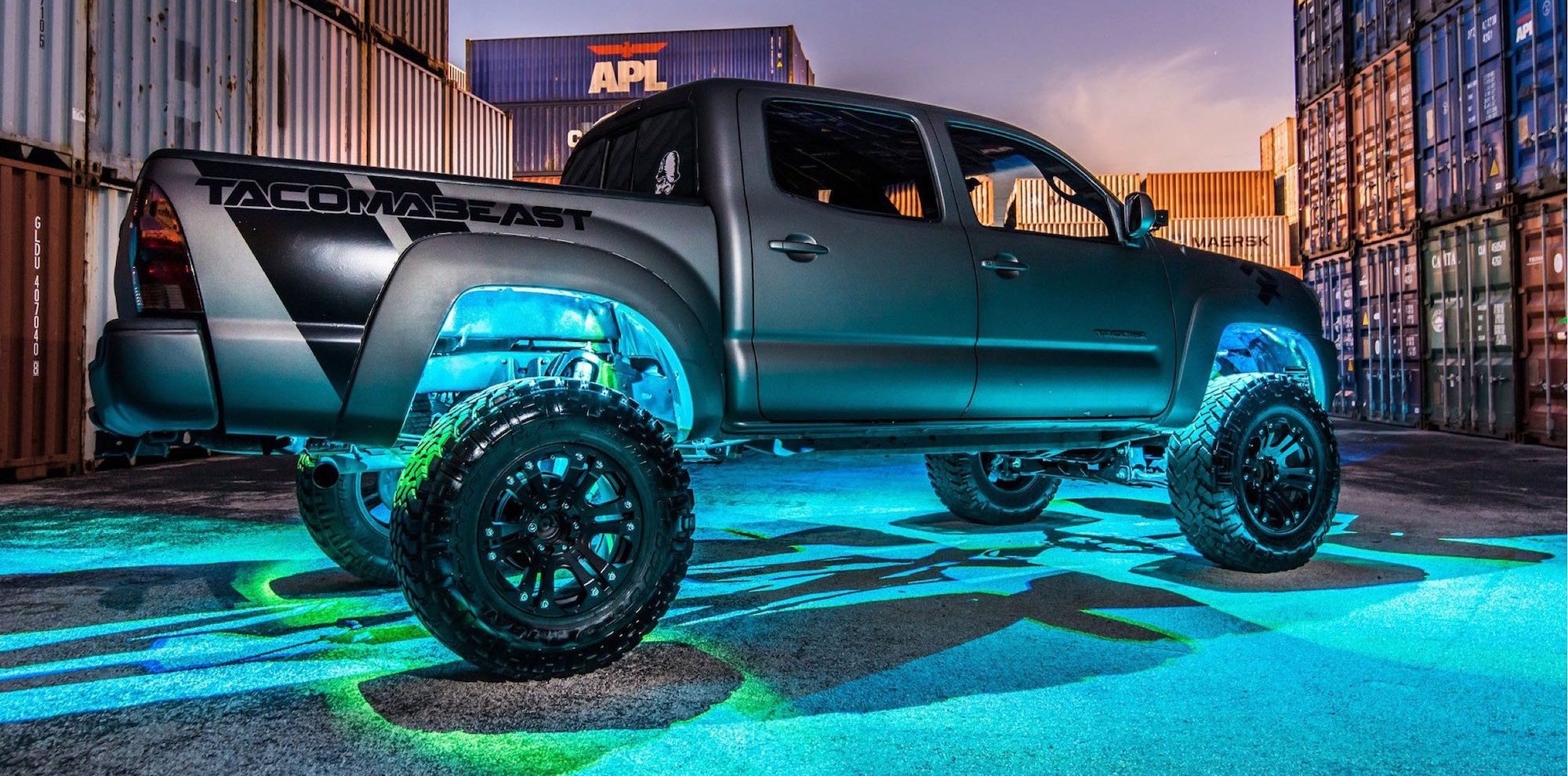
Photo on theretrofitsource.com
Exterior accent lights
Are placed on the car body. They make the car more visible at night and make it look cooler. They can also be used to illuminate car steps.
Rock lights
These are vital for off-road car use. They allow the driver to see the area around them more clearly. They can be mounted on the front, or rear of the car to help you notice rocks or obstacles you would not be able to see.
LED signal lights
By replacing the whole assembly or just the bulb with an LED one, you can turn your stock signal lights into LED ones.
Truck bed lights
These illuminate the truck bed, they allow you to work at night without the use of a flashlight.
LED fog lights
They are used to increase visibility in foggy, rainy or snowy conditions. They allow another driver to see your car. They are often mounted on the front or rear.
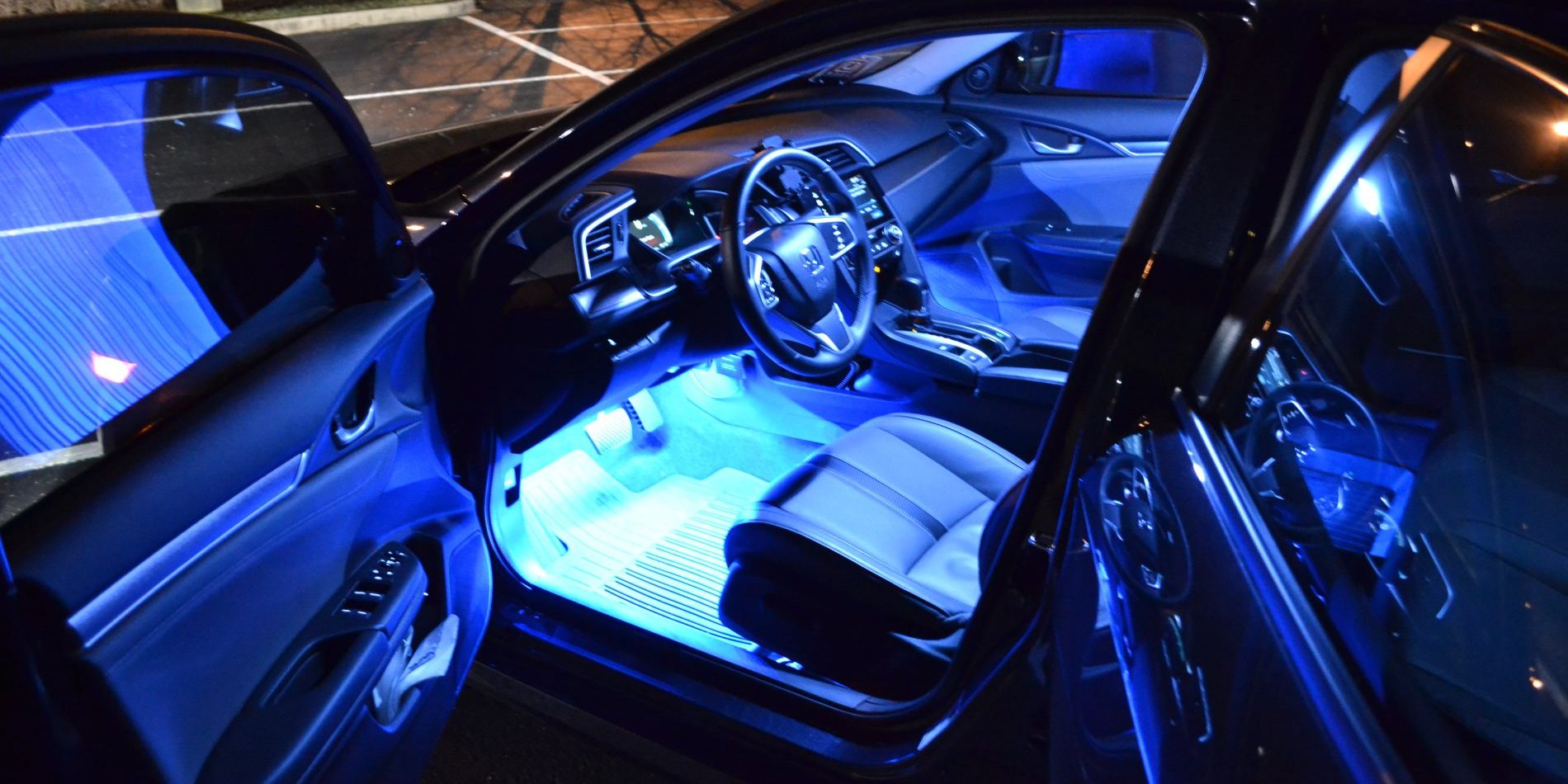
Photo on kiddingall.com
Ways to improve your car interior with LEDs
An easy, simple way to upgrade your car interior is to add LED lights and strips. They are small, bright and versatile, allowing for flexibility in customizing your car interior. As mentioned above, LEDs have a lot of advantages making them ideal for sprucing up the cabin. You can use LED replacement lights to upgrade the car’s dome, map, glove box, step and trunk lights. How accessible the bulbs are will depend on the make and model of your vehicle. A lot of the cars have a plastic lens cover secured by clips or screws. In some models, the dome and map lights are housed in a unit held in place by metal clips. Using a screwdriver and a fair amount of skill, remove the lens covers and units and replace the incandescent bulbs with LEDs. Make sure to select the right lamp and color for the holder. Before returning the housing units, test the lights to see if they are working. You can also use LED strip kits to customize your car further. They are easy and fun to install, bathing the car cabin in different ambient colors. You can stick LED strips under the dash, to the car roof, or on the floorboard. Use a 12V adapter or a hardware kit to connect the strips to the car’s electrical system. A lot of the kits come with a remote to control the color variety and modes. Remember replacing the bulbs is easy and does not need any specialized tools, or skill, just follow the car manual.LED bulbs have positive and negative ends, make sure that they are placed correctly in the holder.Make sure to check the regulations in your area to see if there are restrictions to adding aftermarket lights to your car interior.
Can you put LED light bulbs in the headlights?
How to install LED lights in a car headlight
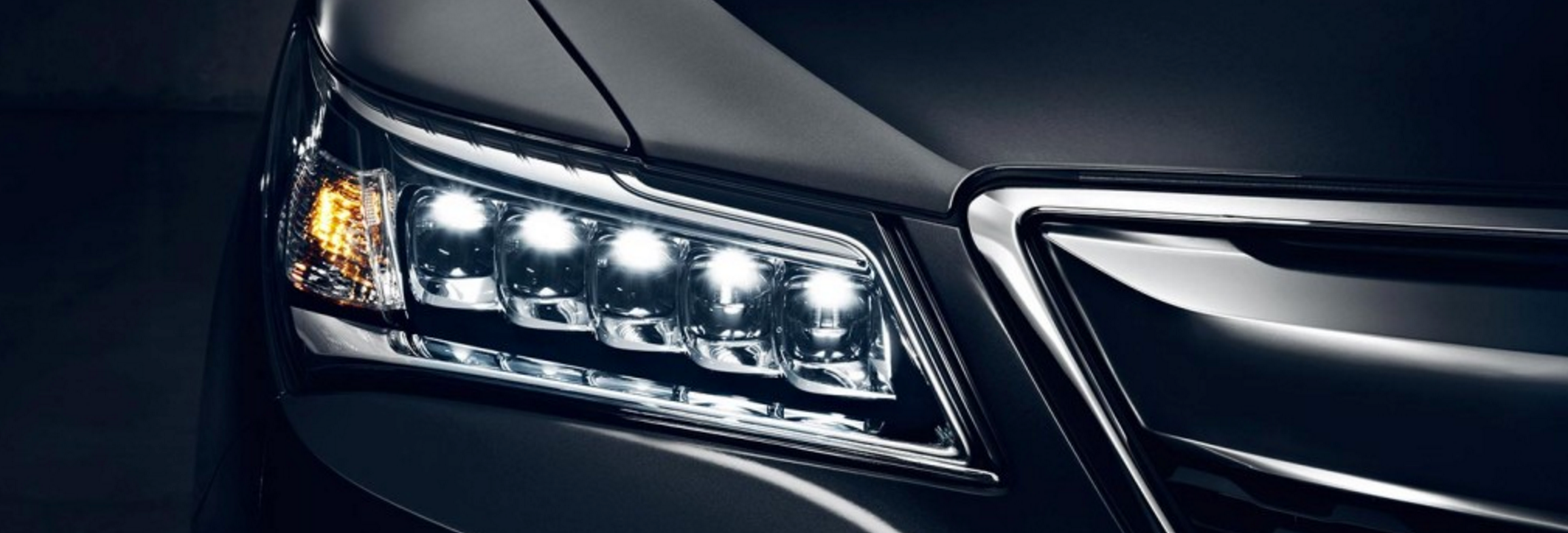
Photo on bestheadlightbulbs.com
They are the most recent revolution in headlight technology. Car manufacturers are moving away from halogen and HID lamps and opting for more durable LEDs. When choosing car headlights; First, you need to thoroughly understand the components of a headlight, the difference between a bulb and a sealed beam headlight as well as the pros and cons of using LEDs. Second, you should know what affects LEDs and thirdly the bulbs or kits chosen should be compatible with your car. You should know what kind of beams your car headlights emit. They can be low, high or dipped.
How to pick and install the correct LED kit for your car?
Step 1: Find out the type of bulb in your car headlights. It can either be a: – Single beam bulb where the high and low beams use different bulbs – Dual beam bulb where both beams are combined in one bulb.Be sure to get the same style replacement LED bulb that will fit into the same headlight housing as the current bulb. You can search the web for your car’s bulb type, check the vehicle’s manual, check from the manufacturer or your local dealer or check under the bulb for the information you require. Remember to get the correct color temperature bulb.Step 2: Get an LED conversion kit for your headlights and prep for installation.You can now get a conversion kit now that you know the bulb type. There is a wide variety of then available online. Before you remove the old headlights, you can use them as a template for the headlight beam. After installing the new headlights, you can check if they fit into this template. Once you get your kit, make sure all components are there. There should be two LED bulbs, two ballasts, the wiring, and terminated connectorsStep 3: Remove your old bulbs. Lift the hood of the car and remove the headlights. Locate the back of the bulb, remove the wiring connector and twist the bulb out. Be careful not to break anything as it will require you to replace the headlight housing.Step 4: Install the LEDs. Using a clean rug, or gloves replace the LED bulb by twisting it in and securing it. Do not overtighten them as you might break them.Step 5: Attach the ballast. Ballast is used to limit the current load to the LED circuit. There are two connectors on the ballasts one goes to the bulb and the other to the car’s wiring.Make sure you fix the ballasts securely if they moved around they could get damaged, or the wires could pull apart and fray.Step 6: Test out your new LED headlights. Fire up your car and test out the new headlights. They should light up right away, if not retrace your steps to see what might be wrong. Try out the lights against the template you made earlier if it is off, simply adjust it.
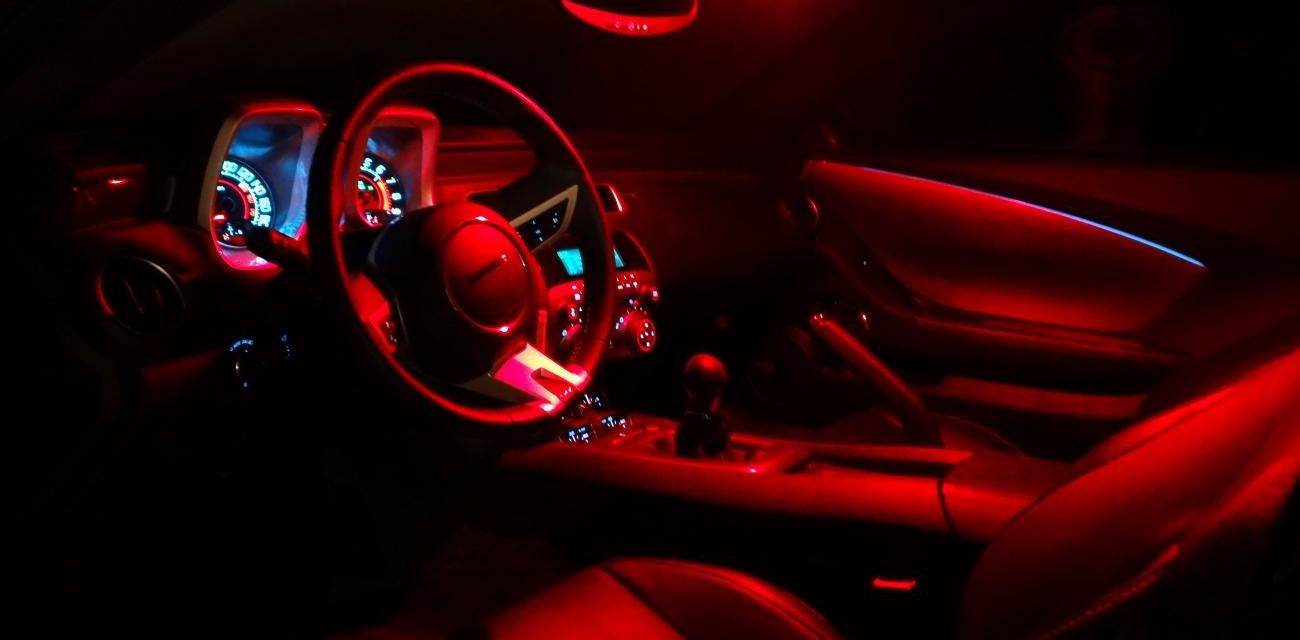
Photo on camaro5.com
Here are several steps to follow when replacing or upgrading car interior lights
Under-dash lights
These are the lights found in the footwells of the car.
- You will need to attach the LED strip to a piece of wood or something similar. Make holes and cuts needed to mount it properly. You can use zip or cable ties because they are cheap and easy to use.
- Using a soldering iron make some leads on the strip to connect it to a power source later.
- Adhere the LED strip to the piece of wood and mount it under the dash. Find a power source and connect it to the strip. If the strip has control switches, do not forget to attach them too. They will allow you to turn on the lights and switch between different color modes.
Dome lights
These lights are found on the car roof.
- Remove the unit casing of the stock light to expose the assembly below.
- Replace the incandescent bulb.
- Test it out and replace the unit casing.
Trunk lights
- First, find a metallic momentary button, this will turn the lights on when the trunk door is opened, and an override 10A/12V switch.
- Remove the interior cargo panels and the trunk panel. Cut out a hole to fit the momentary button.
- Make sure you attach one end of the button to the chassis to ground it and solder a wire to the other end. Attach this wire to the override switch.
- Taking the lead and a positive, attach it the LED strip and mount it.
- For LED bulbs, you can just replace the stock trunk bulb with an LED one.
Dashboard gauge console
Take the gauge cluster plastic cover out carefully and locate the stick bulbs and sockets.You can replace the LED bulbs into the stock fixtures or attach LED strips and stick them onto the plastic cover. Make sure you remember how everything is set up, so you can easily put it back together.
